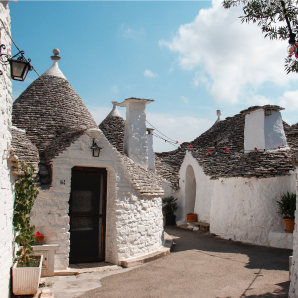IL TERRITORIO
CERIGNOLA: IL PUNTO D’ORIGINE
I vitigni e i campi della Cantina si estendono nel territorio della Daunia, nel Basso Tavoliere, abbracciato a nord dal promontorio del Gargano e a ovest dai monti del Subappennino Dauno, e protetto grazie al golfo di Manfredonia dai freddi venti dei Balcani a est.
La vite cresce rigogliosa su questa terra sin dai tempi più antichi. Si racconta che Diomede, l’eroe greco della guerra di Troia, sbarcò nella Daunia e piantò tralci di vite, importati dall’Asia Minore, su questo territorio che dettero origine al Nero di Troia, il vitigno autoctono pugliese per eccellenza. Nel 1800 Cerignola esportò il Nero di Troia sino in Francia dominando il mercato enologico.
Una distesa di vitigni, coltivati con il sistema a pergola pugliese, il metodo più usato perché protegge la vite dai raggi solari, colora gran parte del territorio della Daunia. Le varietà di vitigni maggiormente destinate all’imbottigliamento sono le uve autoctone come il Nero di Troia, il Negroamaro e il Primitivo.
UNA LUNGA STORIA DI TERRITORIO SCOPERTA E PASSIONE NATA NELL'ANTICHITÀ CHE PORTIAMO AVANTI CON CURA PER IL TERRITORIO E PER LE TRADIZIONI.
LA NOSTRA
TERRA: LA
PUGLIA
Da ormai diversi anni, la Puglia è universalmente riconosciuta come una delle regioni più belle del mondo. Ricca di culture e tradizioni, figlie di dominazioni diverse succedutesi nei secoli. Terra del mare e del sole, il tacco d’Italia è anche la patria delle masserie e di tanti inconfondibili panorami che hanno affascinato milioni e milioni di turisti.
A far sognare è ogni angolo della Puglia: dalla spiaggia di Pizzomunno, con la leggenda legata al monolite che la domina, alle scogliere da cartolina di Polignano a Mare, la città di Domenico Modugno; dai paesaggi incantevoli del Gargano alle acque cristalline del Salento. Stupore e meraviglia colgono tutti gli avventori ai piedi di Castel del Monte, ad Andria, patrimonio dell’Unesco famoso per la sua pianta ottagonale. Sotto terra si nascondono le affascinanti grotte di Castellana, che si sviluppano per 348 metri in lunghezza, 122 in profondità.
Come se non bastasse, la magia della Puglia si riversa anche a tavola, grazie a delle specialità culinarie di livelli eccezionali e tipiche ciascuna del proprio territorio di riferimento.


PUGLIA, TERRA DI MARE E BORGHI CHE RISPLENDONO NELLA LORO ANTICA ARTE.
I VITIGNI
Ogni terra del vino ha il suo protagonista, un vitigno autoctono la cui origine si perde nella notte dei tempi e la Daunia non fa eccezione.
Qui, da sempre, si coltiva il Nero di Troia che, secondo la leggenda, è approdato sulle sponde dell’Adriatico grazie all’eroe attico Diomede in fuga dalla Grecia. Altre fonti raccontano di un vitigno spagnolo del territorio di Rioja portato in Puglia nel 1745 dal governatore Don Alfonso d’Avalos.
In queste terre il vitigno trovò l’ambiente ideale ed ancora oggi rappresenta la massima espressione del territorio. Più probabile il suo arrivo dalle regioni balcaniche, forse passando dalla città albanese di Crujia, come del resto lo sono tanti vitigni europei.
Ricco di tannini, produce vini che sfidano il tempo. Dal Nero di Troia vinificato in bianco, si ottiene uno splendido rosé di colore brillante e che profuma di piccoli frutti di bosco.
Oltre al Nero di Troia è molto diffusa la coltivazione del Negroamaro, presente nella DOC locale fin dal 1974 in percentuali importanti. Meno presente in Daunia il Primitivo, il classico vitigno pugliese originario del tarantino che però, sui nostri terreni, acquisisce carattere di maggior finezza ed eleganza.
I vini bianchi autoctoni si limitano al Fiano, una cultivar clone del ben noto Fiano di Avellino, e al Bombino, una probabile variante del più noto Trebbiano, ma più profumato e sapido, tanto da diventare protagonista di ottimi spumanti Metodo Classico nelle zone più fresche a nord della Daunia.
Questa splendida tavolozza di colori e profumi è la base del nostro lavoro, volto da sempre alla valorizzazione della cultura enoica della nostra terra, così ricca di tesori ancora tutti da scoprire.

NERO DI TROIA

PRIMITIVO

NEGROAMARO

FIANO

